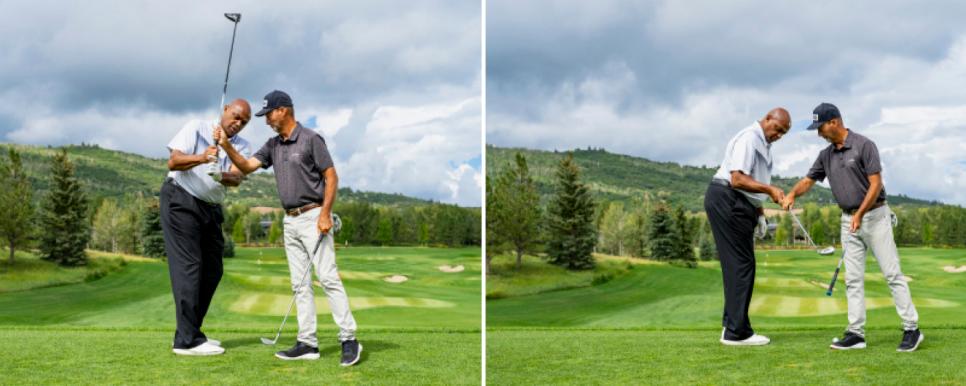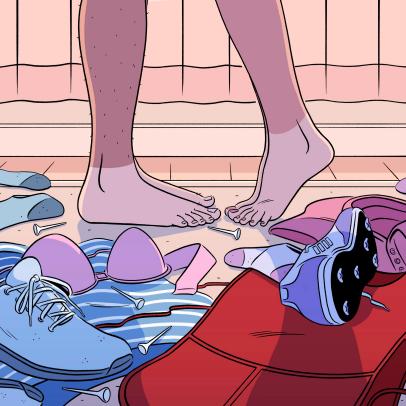Smoking it!
This coach fixed Charles Barkley’s ’sh---y swing’ — and now he’s got some advice for you

John Loomis
It's 10 minutes before a late-summer lesson at the Maroon Creek Club in Aspen, Colo., when Charles Barkley pulls up in his cart—engaging and endearingly profane even after going deep the night before in the town’s posh entertainment district.
His needle is long and sharp, and it’s easy to see why he’s the heavyweight champion of NBA studio analysts at TNT and effortlessly popular in his moonlight gig, calling silly-season celebrity golf broadcasts for TBS.
A photographer, who is there to document the lesson for this story, holds up a spray-painted gold driver for Barkley to pose with (below). At first glance at the club, Barkley recoils like he’s been served a $3 steak. “Was this your idea?” he says to the photographer. “Because it’s terrible.” Later, during the video part of the shoot, the man who is a veteran of thousands of hours of live television and countless national advertising spots gives the side-eye to a director who gets a little too specific with direction. “You got it, Francis Ford,” Barkley says.

John Loomis
Sir Charles doesn’t look like a player whose golf game has been under the equivalent of open-heart surgery for the past 20 years—getting sliced, diced and dissected by more coaches (armchair and otherwise) than anyone this side of Tiger Woods. He moves much better than you would expect for a 59-year-old big man with more than 1,000 NBA games on his odometer. He had both hips replaced and is getting ready to have the same done to his shoulders, but he still looks like he’s ready to muscle up in the paint.
Ignoring all the shorter clubs in his enormous Ping staff bag, Barkley pulls out his driver—customized in Auburn University’s blue-and-orange color scheme (his alma mater)—tees one up and gets ready to make his first swing of the day. It’s as if everyone has collectively held their breath to see what happens next. Having all eyes on him isn’t a new phenomenon. Barkley glances up and smiles.
“You watch,” Barkley says to anyone within earshot. “Stan Utley fixed my shitty swing.”
FIX 1: GET RID OF THE ‘FORCED’ LAG

Barkley’s full-swing hitch was just physics, says Stan Utley, pictured with the Hall of Fame basketball player here. Barkley would pull the handle down hard in the downswing, making his path steep while lagging the clubhead way behind (above, left). From that position, something drastic had to happen to let the clubhead catch up before impact—like Barkley’s stop-and-go hitch. Utley’s cure was to get Barkley to feel an earlier “throw” (above, right) of the clubhead with his wrists by having him hit right-arm-only pitch shots. That helped him feel the unhinging of his wrists, not only at the right time but in the right direction. Then he took that feel to his driver swing (below).

John Loomis
There's a recent you can't look away when a quarterback gets crushed on a blind-side hit, a boxer gets punched in the groin or a NASCAR driver goes cartwheeling down the back straight at Talladega in a 20-car pileup. We’re hard-wired to gawk at the spectacle. (They built the Colosseum for it in Ancient Rome.) It’s why everybody knows exactly what this retired NBA power forward’s golf swing looks like even if they don’t know the difference between a jump shot and a jump start. Barkley is a genuine sports hero, television star and celebrity pitchman, selling Subway sandwiches, AT&T cellphones and Dick’s Sporting Goods in every other commercial—but he’s also that guy with the hitch.
For more than 20 years, Barkley hit almost every full shot with the golf equivalent of a stutter step. Halfway down, it was like he ran on electricity and everything went unplugged. His arms would stop; the club stopped. But then the power would come back on with just enough time for a desperate late lurch at the ball. Barkley went from being a reliable 70s-shooter to going full rounds without getting the ball airborne. Not only was it bad, it was on display in televised events, like the American Century Celebrity Golf Championship in Lake Tahoe, and in money matches with other alpha athletes like Tiger and Michael Jordan. Because of his swing, Charles had become the designated pigeon. When he wasn’t being laughed at in prime time, he was on lowlight reels across every social-media channel—all of it on auto-play.
A sane person would quit, and Barkley basically did. He went from playing 200 rounds a year to maybe five, all at charity events around Phoenix. “People wanted to pay their money to come see my swing up close. It was miserable,” he says. “It just sucks playing bad golf and constantly getting made fun of. I just got tired of getting my ass kicked.”
FIX 2: UNHINGE, SHIFT AND RELEASE

John Loomis
Barkley’s main swing thought now? His first downswing move with his wrists is to unhinge them away from the target. Pairing that with a healthy turn and shift means that the club comes down on a much better plane with no effort or manipulation of his hands. Instead of taking ugly, crooked divots, he now skims the ground through impact, even with his wedges. “He hit balls for two hours here, and all he did was bruise the grass,” Utley says.
Release is a term that gets thrown around a lot, but this is what it really looks like through impact (above). This is tour-pro quality, Utley says. Check out where Barkley’s thumbs are pointing—down where the ball just was. His right arm isn’t twisting up and above his left arm, and the clubface isn’t held open or rolled closed. This is a from a guy with two fake hips and two shoulders that need replacing.
It was at one of those charity events, Tom Lehman’s Elevate Phoenix Invitational in 2017, where Barkley first ran into Utley, the short-game guru and former PGA Tour player. The low-key Utley waited for a quiet moment and then casually asked if the two Phoenix-area residents could get together so he could watch Barkley hit a few balls. Barkley had heard that pitch before.
“I tried everything. I even tried playing left-handed for a couple of years,” Barkley says. “I told Stan there wasn’t anything left for anybody to tell me. I’d already taken a lesson from everybody.”
“One more won’t hurt,” Utley said.
Utley presented his theory about why Barkley had developed his famous instruction-proof hitch. “It was obvious that he pulled the handle down and wasn’t swinging the head until after he hitched,” Utley says. “I felt like that was because he misunderstood what he was supposed to be doing.”
Utley asked Barkley to hit some basic pitch shots with just his right hand while focusing on something very different. “He’s such a good athlete and has such good hands, he immediately started hitting it solid,” Utley says. “His instinct let him pitch the club out there with his wrist. But his concept of what he was supposed to be doing wouldn’t let him do that with two hands on the club. His idea was that you had to lag the clubhead to hit it far, and it evolved into something that prevented him from being able to play golf.”
The term “lag” might conjure a picture of Sergio Garcia’s dramatic transition from backswing to downswing, where the angle between his forearms and the club’s shaft shrinks drastically. Utley’s advice for Barkley was borne from work Utley did as Garcia’s short-game coach in the early 2000s.
“Sergio’s issue was basically identical to Charles’, but Sergio’s was with his chipping,” Utley says. “It was delaying the release of the club too long. Sergio could delay the release on a full swing—or at least make it look like he was delaying it—but he had time to get to the ball. On a chip, he didn’t have enough time. With Charles, I don’t think anybody ever held the angle—the lag—as long as he did, and the hitch was the only way he could have time to catch up and hit the ball.”
About 40 minutes into that first session, Barkley had his two-handed “eureka” moment: “You mean you want me to throw the clubhead with my wrists backward?”
Barkley’s downswing issue was extreme, but the cure was something almost every player can apply to look more like a golfer (and less like a lumberjack having a seizure). “Whether you have a hitch or are just a 20-handicapper who wants to get better, that’s going to happen only if you understand how the club has to unwind to get to the ball,” Utley says. “The head has to take the longest journey, which means you need to get that part going sooner than you probably are. That means learning how to hinge and unhinge your wrists.”
Barkley didn’t see Utley again until a year later, and when they reunited, the hitch had retreated and Barkley was able to switch gears and get the fine-tuning every avid player with plenty of free time and a taste for betting wants—a better short game. Now that Barkley could use his hands appropriately, it was time to make the ball check and dance. Utley schooled Barkley on ways to control the face of a lofted wedge, so he could change between high floaters and low, checking pitches.
FIX 3: CLOSE THE FACE

Gaining control over the clubface also pays off in the short game. Barkley’s old tendency was to open the face (above, left) and tip his shoulders away from the target on the downswing. That caused mis-hits and scoops. Now he’s starting back with the face more closed (above, right). He then turns the shaft to the left on the way through. If you do this, you’ll chip and pitch the ball lower with more spin and distance control. Another thing Utley got Barkely to do around the greens is to start tall and then get even taller through impact—like Utley is demonstrating (below). Everything about Barkley’s old swing was tight and anxious, and he dipped his knees and got “smaller.” Good pitch shots—and full swings—have extension, but that doesn’t mean keep your arms rigid. When you hyperextend your arms, your hands and wrists are restricted and move slower. A good swing thought is to feel like your arms are relaxed and your body is stretching upward through impact.

John Loomis
“I play every day now, and I’m playing real golf,” says Barkley, who shot 80 three times over the summer and plays as a 10 handicap. The rejuvenated swing was on display in May during a pro-am at a PGA Tour Champions event in Barkley’s home state of Alabama. Barkley pured a hitch-free drive on the first hole while fellow Auburn sports legend Bo Jackson watched in astonishment.
“I could kiss you full on the mouth right now,” Jackson said. In July, Barkley shot three rounds in the 90s at the annual American Century Championship—betrayed not by his swing but by his body protesting three straight days of 18-hole walks. “It opened my eyes that I have to be in better shape,” he says. “I’d get to the 14th or 15th hole every day, and I was just done.”
For Utley, Barkley’s triumphant performances or full-throated endorsement isn’t the thing that is most satisfying about the project. It’s the impact. “I went to his New Year’s Eve party, and a group of his buddies came over and hugged me,” Utley says. “Their friend was happy on the golf course again. He got the joy back.
“People ask me all the time how I fixed Charles’ mental problem. He didn’t have a mental problem; he had a mechanical issue that was making it impossible to swing with any confidence. It doesn’t mean he’ll never hit another bad one. But he owns his swing now. He’s built a new pattern.”
Back on the private practice tee at Maroon Creek, Barkley has tossed the gold-painted club and is getting ready to make that first swing with his driver. He rips a tight draw 340 yards into the breeze and watches it roll onto the base of the busy members’ practice tee at the other end of the range.
He turns and gives his famous Barkley smile: “Let’s see them scatter.”
HIS TOUGHEST MATCH
Stan Utley is thriving through a major health challenge

John Loomis
You know who Stan Utley is because of his hands.
In his PGA Tour playing career, Utley never averaged much more than 250 yards off the tee, but he had one of the most consistently excellent short games in golf. He won the PGA Tour’s 1989 Chattanooga Classic, and still holds the record for fewest putts over nine holes with six—set at the 2002 Air Canada Classic.
Since the early 2000s, Utley has made his living teaching tour players and amateurs alike from his bases at Grayhawk Golf Club in Scottsdale and Maroon Creek in Aspen, Colo. He’s still demonstrating the short game technique that made him the envy of his peers and the one they consistently sought out for early-week pointers when he was on tour.
Charles Barkley is his most celebrated recent student, but Utley has worked with champions and major winners such as Sergio Garcia, Inbee Park, Darren Clarke, Joaquin Niemann, Rocco Mediate and Jay Haas.
Knowing his impact on people’s lives, Utley was distressed when he came out of a program of chemotherapy for non-Hodgkins lymphoma in 2019 with a faint but noticeable tremor in his left hand. Like a surgeon’s, Utley’s hands are the tools of his trade.
One of Utley’s students is a neurologist and identified the tremor as the potential onset of Parkinson’s Disease. (Parkinson’s is a progressive degenerative disorder of the central nervous system.) After a battery of testing at Barrow Neurological Institute in Phoenix, the diagnosis was confirmed. “They told me I was already susceptible to Parkinson’s,” says Utley, 60, who last played on the PGA Tour Champions in 2016. “But the trauma of chemotherapy is probably what caused it.”
Utley’s form of the disease manifests in part as a resting tremor, which goes away when he holds a club. “It doesn’t really affect my game too much,” says Utley, who shot 69 at Pebble Beach’s Spyglass Hill Golf Course in September. “My good golf isn’t too far off from where I was 10 years ago. My swing is probably better because I’ve gained so much knowledge being around great teachers like Jim Hardy and Rob Akins.”
An aggressive workout regimen and a determination to stick with his busy coaching schedule has meant that the disease hasn’t been much more than a nuisance. “Attitude has so much to do with living a healthy life,” says Utley, who trains with fitness specialist Carson Kemp at Motionlab in Scottsdale. “I’m going forward fast, hard and positive. I’m teaching my normal schedule. I don’t plan on slowing down.”
Watching Barkley’s practice ethic has been another motivator. “I’ve never seen somebody work so hard on his game like Chuck has for the last two years.” Utley says. “Hundreds of hours on his own, putting in the time. When you have hope and you put in the work in, you’ll get better.







